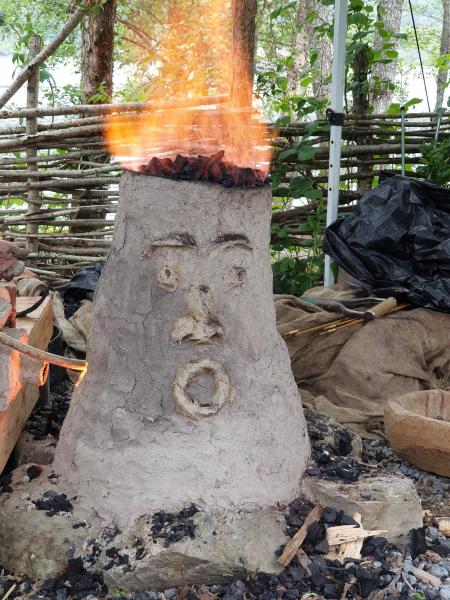The challenge is to smelt iron – it is the Iron Age we’re interpreting at the Scottish Crannog Centre after all, and iron was their new state of the art material!
We had already prepared our furnace, a big ceramic cylinder into which we put charcoal and bog ore – yes, it does come from bogs and it’s a red mud that was widely used as an iron source. The process is called bloomery smelting where the impurities are melted out of the iron ore at about 1300 degrees Celsius and a nice lump of hot sold iron sticks together in the furnace. Perfect for then heating in the forge where a blacksmith shapes it into knives, rings, tools etc.
But how to get the furnace up to 1300 degrees celsius? Everything else was ready, we just needed bellows to push air into the furnace and increase the temperature. We’re basically making a tiny volcano here! The archaeological evidence for bellows or furnaces for that matter from this time period is fairly limited. There are many types of bellows we know about today, partly through ethnographic study, including pot bellows, bag bellows, box bellows and even blowpipes. Maybe the Iron Age Crannog dweller used little bag bellows. But we have a great big furnace which would mean we’d need lots of bag bellows and lots of bellow workers all working for about 6 hours non-stop. Since that would be incredibly labour-intensive, we chose a design loosely based on Medieval Great Bellows, but the design may well go back a good bit further than that. One big set of bellows meant only one operator at a time.
Making Great Bellows was quite a challenging project for Technology Interpreter, Emma. There were valves to wrangle with, leather to be selected, many a piece of wood to cut out and an ever-present doubt that they may be too small. But after many days and weeks of planning, sweating, hammering, cutting and worrying, the huge bellows puffed their first puff of air.
And, we’re happy to say the first Crannog Centre iron was successfully smelted during our Iron Age Ingenuity event at the end of May with the hard work of our new big bellows, our volunteers and staff at the furnace.



